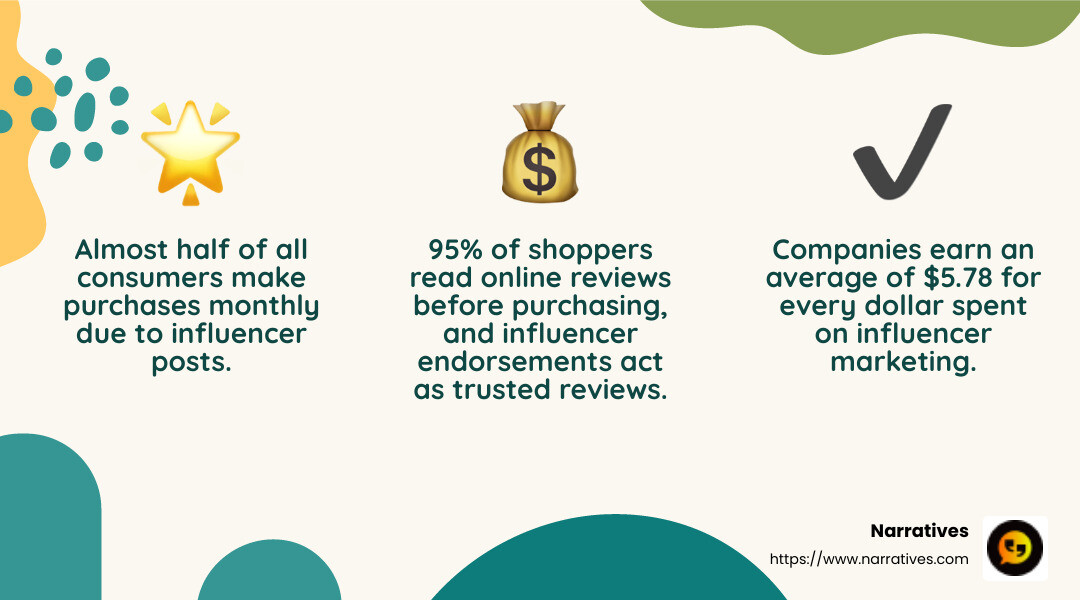Power of Influence: Understanding Social Media Marketing

The Power of Influence: How Social Media Marketing Influencers Drive Brand Promotion
Social media marketing influencers are making waves across digital platforms, leveraging their significant online presence to promote brands effectively. These influencers are content creators who collaborate with brands to share sponsored posts, reviews, and endorsements, directly shaping consumer preferences and purchasing decisions.
Key Points:
- Social media marketing influencers use various platforms like Instagram, TikTok, and YouTube to reach audiences.
- They partner with brands to create authentic content, providing real value and credibility.
- Their influence significantly impacts brand exposure and awareness, driving engagement and sales.
In today's digital world, social media is not just about personal connection—it's a vital marketing tool. Influencers act as the bridge between brands and consumers, changing abstract marketing messages into relatable content. By tapping into the power of these influencers, brands open up a new field of possibilities for exposure, authenticity, and connection with their target audience.

What is Influencer Marketing?
Influencer marketing is a form of social media marketing where brands collaborate with influencers to promote their products or services. This strategy focuses on leveraging the influencer's credibility, reach, and authentic connection with their audience.
Endorsements and Product Mentions
At its core, influencer marketing revolves around endorsements and product mentions. Influencers share their personal experiences with a product, often in a natural and relatable way. This approach builds trust among their followers.
For example, when a beauty influencer mentions a skincare product in their daily routine, it doesn’t just highlight the product; it also provides a personal recommendation that followers value.
The Power of Collaboration
Collaboration is key in influencer marketing. Brands and influencers work together to create content that resonates with the influencer's audience while aligning with the brand's message. This partnership ensures that the content feels genuine rather than forced.
Consider a campaign where a fitness influencer collaborates with a sportswear brand. Together, they create workout videos featuring the brand's products, seamlessly integrating the brand into the influencer's lifestyle content.
Why It Works
Influencer marketing works because it taps into the influencer's established trust and rapport with their audience. Followers see influencers as peers, not just marketers, which makes their recommendations more impactful.
In fact, a Q3 2023 Sprout Pulse Survey found that over 80% of marketers believe influencers are essential to their social media strategy. This highlights the growing importance of influencer marketing in reaching and engaging target audiences effectively.
By understanding the dynamics of influencer marketing, brands can harness the power of social media influencers to improve their marketing efforts and connect with consumers on a deeper level.
Types of Social Media Marketing Influencers
When it comes to social media marketing influencers, not all are created equal. They vary in follower count, niche specificity, and engagement levels. Let's break down the four main types: Mega, Macro, Micro, and Nano influencers.
Mega Influencers
Mega influencers are the celebrities of the social media world. With over a million followers, these influencers boast massive reach and exposure. Think of them as the A-listers of Instagram or TikTok. Their audience is vast, but it’s also broad, meaning their engagement rates might not be as high as smaller influencers. While they can be pricey, their ability to reach a wide audience makes them appealing for brands looking for extensive visibility.
Macro Influencers
Macro influencers sit in the sweet spot between mega and micro influencers, with follower counts ranging from 100,000 to 1 million. They are often seen as experts in their field and have built a substantial reputation. Brands love macro influencers because they provide a significant reach within a more targeted community. These influencers often have a dedicated following, making them a valuable asset for campaigns aiming for both reach and engagement.
Micro Influencers
Micro influencers have between 10,000 and 100,000 followers. They might not have the vast reach of mega influencers, but they make up for it with higher engagement rates. Micro influencers often focus on a specific niche, allowing them to connect deeply with their audience. This makes their endorsements feel more genuine and trustworthy. For brands, collaborating with micro influencers can be more cost-effective while still ensuring a targeted reach.
Nano Influencers
Nano influencers are the smallest players in the influencer world, with fewer than 10,000 followers. Despite their limited reach, they often have the strongest connections with their audiences. Their content is highly personable, and they can dedicate more time to brand partnerships. This makes them an excellent choice for brands looking to reach a highly specialized audience. Plus, they’re the most budget-friendly option, perfect for smaller brands or niche products.
Each type of influencer brings unique strengths to a marketing campaign. By understanding these differences, brands can strategically choose the right influencers to meet their goals, whether it's broad exposure or deep engagement within a niche community.
Benefits of Using Social Media Marketing Influencers
When it comes to leveraging the power of social media marketing influencers, businesses can open up three significant benefits: increased brand exposure, cost-effectiveness, and improved credibility. Let's explore each of these advantages.
Brand Exposure
Collaborating with social media influencers expands your brand's reach far beyond traditional advertising methods. Influencers introduce your products or services to their followers, many of whom may be unfamiliar with your brand. According to the 2024 Influencer Marketing Report, almost half of all consumers make purchases at least once a month because of influencer posts. This demonstrates the potential for influencers to significantly boost your brand's visibility and awareness.
Cost-Effective Marketing
Influencer marketing is not just effective; it's also budget-friendly. Companies earn an average of $5.78 for every dollar spent on influencer marketing. This high return on investment makes influencer partnerships a smart choice compared to other marketing strategies. By selecting the right type of influencer—be it macro, micro, or nano—you can tailor your campaign to fit your budget while still achieving impressive results.
Improved Credibility
Influencers have built trust with their followers, often through authentic and relatable content. This trust translates into social proof for your brand. When an influencer endorses your product, it feels like a recommendation from a trusted friend rather than an advertisement. Sprout Social highlights that 95% of shoppers read online reviews before making a purchase, and influencer endorsements serve as a powerful form of these reviews. By aligning with influencers, your brand can gain credibility and attract quality leads.

Incorporating social media marketing influencers into your strategy can transform your brand's presence and perception. By focusing on brand exposure, cost-effectiveness, and credibility, you can harness the full potential of influencer partnerships. This leads seamlessly into crafting an effective influencer marketing strategy, where identifying goals and finding the right influencers are key steps.
How to Create an Effective Influencer Marketing Strategy
Creating an effective influencer marketing strategy involves several key steps. Each step helps ensure that your campaign aligns with your brand's objectives and resonates with your target audience. Let's explore these steps:
Identify Goals
Start by defining what you want to achieve with your influencer marketing campaign. Are you looking to increase brand awareness, drive sales, or launch a new product? Clear goals will guide your strategy and help you measure success. Setting specific objectives is crucial for understanding the impact of your campaigns.
Determine Audience
Knowing your audience is essential. Consider who your ideal customers are and what problems they face. Identify the social media platforms they frequent. This information helps you tailor your campaign to reach the right people. Use audience demographics to ensure your influencers' followers match your target market. This alignment is key to an effective campaign.
Create Budget
Setting a budget is vital. Decide how much you can afford to spend on influencer marketing. Influencer marketing can be cost-effective, as companies earn an average of $5.78 for every dollar spent. Allocate resources wisely by choosing influencers who offer the best value for your investment.
Find Influencers
Choosing the right influencers is critical. Look for those whose content aligns with your brand message and who have a strong engagement rate. Relevance, reach, and resonance are the three R's to consider. Influencers who genuinely love your brand and products can improve authenticity and audience trust.
Track Metrics
After launching your campaign, monitor its performance. Track engagement metrics like likes, comments, and shares to gauge audience interaction. Measure brand awareness through views, clicks, and website traffic. Use tools to tag and track campaign-related posts. This data will help you optimize your strategy for better results.
By following these steps, you can craft a well-rounded influencer marketing strategy that effectively leverages the power of social media marketing influencers. This approach ensures your campaign is aligned with your brand's goals and resonates with your target audience, paving the way for successful partnerships and impactful results.
Social Media Marketing Influencers and Non-Profits
When it comes to non-profits, social media marketing influencers can be a game-changer. These influencers are not just about boosting brand awareness. They can also help non-profits tell powerful stories, engage communities, and drive social impact.
Storytelling
Storytelling is at the heart of non-profit work. Influencers excel at crafting narratives that resonate with their followers. When influencers share a non-profit's mission, they help bring its story to life. This storytelling can humanize complex issues and make them relatable. For instance, influencers might share personal stories or highlight the experiences of those benefiting from the non-profit's work. This approach can turn abstract causes into compelling narratives that inspire action.
Community-Driven Engagement
Non-profits thrive on community support, and influencers can amplify this. By leveraging their platforms, influencers can foster a sense of community around a cause. They encourage followers to participate, whether through donations, volunteering, or spreading awareness. Influencers can host live Q&A sessions, engage in meaningful conversations, and create content that sparks dialogue. This engagement builds a community of advocates who are passionate about the non-profit's mission.
Social Impact
The ultimate goal for non-profits is to create a positive social impact. Influencers can play a crucial role in this by reaching audiences that traditional marketing might miss. They can highlight the tangible outcomes of a non-profit's work, such as the number of lives improved or environmental changes achieved. By showcasing these impacts, influencers help build trust and credibility for the non-profit, encouraging more people to get involved.
Incorporating social media marketing influencers into non-profit strategies can significantly improve their reach and effectiveness. Through authentic storytelling, community-driven engagement, and a focus on social impact, influencers can help non-profits achieve their goals and make a lasting difference.
Frequently Asked Questions about Social Media Marketing Influencers
What platforms are most popular for influencer marketing?
Instagram, TikTok, and YouTube are the top platforms for influencer marketing. Each platform offers unique advantages:
Instagram is a favorite for micro and medium influencers due to its visual focus and user-friendly features like Stories and Reels. It's perfect for brands aiming for visually appealing content and quick engagement.
TikTok attracts macro and mega influencers because of its viral nature and younger audience. Brands can leverage TikTok for creative, short-form videos that resonate with Gen Z and millennials.
YouTube is ideal for long-form content and detailed product reviews. Influencers with a large subscriber base can provide in-depth insights, making it a powerful platform for storytelling and brand education.
How do influencers get paid?
Influencers earn through various methods:
Brand Deals: These are direct partnerships where influencers promote a brand's product or service. Payment can be a flat fee or based on performance metrics like views or engagement rates.
Affiliate Commissions: Influencers receive a percentage of sales generated through their unique affiliate links or codes. This method ties influencer earnings directly to their ability to drive sales.
What makes a successful influencer marketing campaign?
A successful campaign hinges on three key elements:
Authenticity: Influencers should genuinely align with the brand's values and message. Authentic endorsements build trust and resonate more with audiences.
Engagement: High engagement rates—likes, comments, and shares—indicate that the content resonates with the audience. It's not just about reach; it's about meaningful interactions.
Alignment: The influencer's content should align with the brand's goals and target audience. This ensures that the message reaches the right people and has the desired impact.
Incorporating these elements into an influencer marketing strategy can significantly boost a brand's visibility and credibility. Authenticity, engagement, and alignment are the cornerstones of a campaign that not only reaches but also resonates with the audience.
Conclusion
In today's digital landscape, social media marketing influencers play a pivotal role in shaping the narratives that drive brand success. At Narratives, we understand the transformative power of digital storytelling, especially for non-profits and purpose-driven organizations. Our mission is to lift underrepresented voices through high-quality, emotionally resonant multimedia content.
Working with influencers provides an opportunity for non-profits to share their impact stories in a way that inspires action and builds trust. By partnering with influencers who align with their mission, non-profits can increase their visibility and engage with communities on a deeper level.
Digital storytelling is not just about creating content; it's about crafting narratives that resonate. At Narratives, we focus on community-driven storytelling that highlights social impact. This approach not only improves brand credibility but also fosters genuine connections with audiences.
For non-profits seeking to harness the power of social media marketing, partnering with influencers can be a game-changer. By telling stories that matter, these organizations can amplify their messages and drive meaningful change.
To learn more about how Narratives can help your non-profit leverage digital storytelling and influencer partnerships, visit our media services page. Let us help you tell your story in a way that truly makes an impact.


